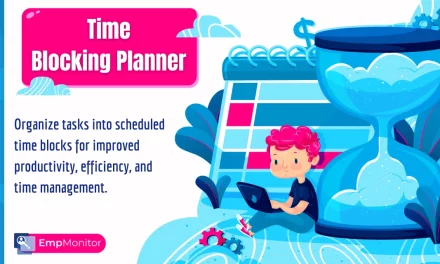Balancing personal life and productivity can be challenging for many professionals, especially when schedules are rigid. This is exactly where flex time becomes powerful. It’s a flexible work model that gives employees the freedom to choose when they begin and end their workday while still meeting business expectations.
Instead of a fixed 9-to-5 routine, flex time allows people to structure their hours based on their personal rhythm. This type of flexible timing increases motivation, improves focus, reduces stress, and supports overall higher performance.
Many companies are also combining flex time with hybrid time work setups (mix of remote + office), making the experience even more adaptable. And with platforms like Empmonitor, management can maintain transparency tracking hours, productivity levels, and performance so flexibility does not reduce accountability.
This guide will explain what flex time really means, the advantages it brings, how managers can apply it effectively, and which tools help make flexible work schedules smarter and easier to manage.
You can Listen to this Blog here,
What Is Flex Time?
Flex time is a work arrangement that allows employees to adjust their start and end times within certain limits while still fulfilling their required hours. Instead of being confined to a strict 9-to-5 schedule, employees can tailor their workday to fit personal needs, boosting both productivity and satisfaction.
The flex time meaning goes beyond just shifting hours. It’s about creating a balance between work responsibilities and personal life, enabling employees to manage tasks efficiently without compromising performance. For example, a parent may choose to start earlier and leave in time for school pick-ups, while another employee might work later to accommodate morning commitments.
Implementing flex time at work requires clarity and structure. Businesses need policies outlining core hours, expectations, and communication guidelines. This ensures that while employees enjoy flexibility, team collaboration, and project deadlines remain unaffected.
With thoughtful planning and the right tools, flex time can transform traditional work routines, making them more adaptable, efficient, and employee-friendly.
Benefits of Flex Time at Work
Adopting flex time can bring significant advantages to both employees and organizations. Here’s why many modern workplaces are embracing this approach:
- Increased Productivity and Focus
When employees can choose work hours that match their peak energy levels, they tend to complete tasks more efficiently. Flexible schedules reduce burnout and improve concentration, making flex time a productivity booster. - Better Work-Life Balance
Flexibility allows employees to manage personal responsibilities alongside professional tasks. From attending appointments to family commitments, flex time at work supports a healthier balance, reducing stress and improving overall well-being. - Enhanced Employee Satisfaction and Retention
Offering flexible schedules signals trust and respect for employees. Satisfied employees are more likely to stay with the company, decreasing turnover and boosting morale. - Positive Impact on Team Performance
Contrary to the belief that flexibility may harm collaboration, teams with well-managed flex time can maintain alignment and productivity. With proper communication and planning, flexible schedules encourage accountability and teamwork. - Attraction of Top Talent
In today’s job market, being flexible is very important. Organizations offering flex time often attract skilled professionals seeking adaptable work arrangements.
By implementing flex time thoughtfully, companies can create a motivated, productive, and loyal workforce while also supporting employee well-being and satisfaction.
How Flex Time Works?
Flex time works by giving employees control over when they complete their work hours while still meeting job expectations. It isn’t a free-for-all schedule; most companies define guidelines to maintain productivity and coordination.
- Core Hours
Many organizations establish “core hours” during which all employees must be available. Outside these hours, team members can adjust their start and end times. This ensures collaboration while allowing flexibility. - Staggered Shifts
Some companies implement staggered shifts, letting employees start and finish at different times. This approach maintains coverage throughout the workday and reduces congestion in shared spaces. - Compressed Workweeks
A compressed schedule allows employees to work the same number of hours in fewer days. For example, a four-day workweek with extended daily hours gives employees longer weekends while keeping total work hours consistent. - Role of Managers
Managers, or flex time managers, play a critical role in ensuring schedules align with team objectives. They monitor workflows, approve flexible arrangements, and address any gaps in coverage or productivity.
When applied correctly, flex time at work enhances efficiency, empowers employees, and keeps teams aligned with business goals.
Flex Time Manager: Best Practices
Managing a flexible workforce requires balance, clear communication, and the right tools. A flex time manager ensures that employees enjoy flexibility while maintaining productivity and accountability.
- Set Clear Expectations
Employees need guidelines on working hours, availability, and deliverables. Defining core hours, deadlines, and communication norms helps avoid confusion and ensures that flex time doesn’t disrupt team performance. - Use a Time Tracking Tool
Monitoring work hours and progress is essential. A time tracking tool helps managers track employee productivity without micromanaging, ensuring that tasks are completed efficiently while respecting flexible schedules. - Regular Check-Ins
Frequent meetings, progress updates, and open communication channels allow managers to address concerns and support employees. This fosters trust and helps resolve challenges before they impact workflow. - Encourage Accountability and Autonomy
Employees should feel responsible for meeting goals within their flexible schedules. A successful flex time manager cultivates a culture of accountability while giving teams the autonomy to manage their hours. - Leverage Analytics
Using tools like Empmonitor, managers can analyze productivity patterns, identify bottlenecks, and make data-driven decisions to optimize flex time at work.
By following these best practices, a flex time manager can ensure that flexible schedules benefit both employees and the organization, creating a more productive and satisfied workforce.
Common Challenges of Flex Time and How to Overcome Them?
While flex time offers numerous benefits, it also presents challenges that organizations need to address to ensure smooth operations.
- Communication and Collaboration Issues
Flexible schedules can make it harder for teams to coordinate. To overcome this, establish clear core hours when all employees are available for meetings and collaboration. Tools for messaging, video calls, and shared calendars help maintain seamless communication. - Maintaining Accountability
Some managers worry that flexibility may reduce productivity. Using a time tracker software or time management software ensures tasks are completed and progress is visible, without micromanaging employees. - Uneven Workload Distribution
When employees work different hours, some may feel overburdened. Regular check-ins and transparent task allocation prevent overload and ensure fair distribution of work. - Resistance to Change
Introducing flex time at work may face pushback from traditional-minded employees or managers. Education, clear policies, and demonstrating productivity benefits help ease adoption. - Monitoring Performance Remotely
For remote or hybrid teams, it’s important to track outcomes instead of just hours worked. Performance metrics, project management tools, and platforms like Empmonitor make it easier to assess productivity objectively.
By anticipating these challenges and applying thoughtful solutions, companies can make flex time a successful, sustainable practice that benefits both employees and the organization.
Also Read,
Tools to Optimize Flex Time
To make flex time effective, businesses need the right tools that simplify tracking, monitoring, and managing flexible schedules. Modern technology ensures flexibility doesn’t compromise productivity.
- Empmonitor: A Complete Time Tracking Tool
Empmonitor is an advanced time tracking tool designed to monitor employee activity, track hours, and measure productivity. It provides insights into work patterns, making it easier for managers to balance flexibility with accountability. - Features that Support Flex Time Management
- Automated time tracking to monitor flexible hours.
- Productivity analytics to identify trends and optimize workflows.
- Attendance tracking and reporting for easy compliance.
- Remote monitoring for hybrid or off-site employees.
- Integration with Time Management Software
Empmonitor integrates with other time management software to streamline workflows. Managers can assign tasks, set deadlines, and monitor performance without interfering with employees’ flexible schedules. - Benefits of Using Tools for Flex Time
By leveraging tools like Empmonitor, companies can:
- Ensure that flex time at work is structured and measurable.
- Maintain transparency between managers and employees.
- Enhance overall team productivity while supporting individual work preferences.
Using the right technology makes flexible time more than just a scheduling perk it becomes a strategic approach that boosts efficiency and employee satisfaction.
Flex Time Tips for Employees
Employees can make the most of flex time by adopting strategies that boost productivity while enjoying the flexibility to manage their own schedules.
- Prioritize Tasks
Start each day by listing high-priority tasks. Knowing what needs to be accomplished ensures that flexible hours are used effectively rather than lost to distractions. - Plan Your Work Around Peak Productivity
Everyone has different energy levels throughout the day. Schedule challenging tasks during peak focus hours and reserve less demanding work for times when energy dips. This approach aligns perfectly with the flex time meaning of working smarter. - Set Clear Boundaries
Flexibility can blur the lines between work and personal life. Define start and end times, and communicate them to colleagues and managers to maintain a balance that supports both productivity and well-being. - Use Time Tracking Tools
Leverage a time tracking tool to monitor hours worked and ensure that tasks are completed on time. Tracking progress helps maintain accountability without feeling micromanaged. - Communicate Regularly
Keep your manager or team updated on progress. Regular updates help maintain collaboration and ensure that flexibility does not affect project deadlines or team coordination.
By applying these tips, employees can take full advantage of flex time at work, achieving better productivity, efficiency, and work-life balance.
Flex Time and the Future of Work
The workplace is evolving rapidly, and flex time at work is becoming a standard rather than an exception. Flexible schedules are not just a perk—they are an essential part of attracting talent, improving productivity, and adapting to modern work demands.
- Support for Remote and Hybrid Teams
With remote and hybrid work models gaining traction, flexible time allows employees to work effectively from anywhere. Flexible hours ensure that productivity remains high, even when teams are distributed across different time zones. - Technology-Driven Flexibility
Analytics, monitoring tools, and platforms like Empmonitor make it easier to implement and manage flexible time. Managers can track work hours, monitor performance, and ensure that goals are met without micromanaging employees. - Enhanced Employee Well-Being
The future of work emphasizes mental health and work-life balance. Flexible time supports these priorities by giving employees autonomy over their schedules, reducing stress, and increasing job satisfaction. - Data-Informed Decision Making
Tracking productivity with tools like Empmonitor provides insights that help organizations refine flexible policies. Companies can identify trends, optimize schedules, and ensure that flexible time benefits both employees and business goals. - Trend Towards Smarter Workdays
The focus is shifting from hours worked to outcomes achieved. As organizations adopt flexible time, the emphasis moves to productivity, efficiency, and results rather than rigid schedules.
By embracing these trends, companies can create a future-ready workforce that thrives on flexibility, accountability, and efficiency.
Also Read,
Conclusion
Flex time is more than just a flexible schedule—it’s a strategic approach to boost productivity, enhance employee satisfaction, and create a healthier work environment. By allowing employees to manage their hours, organizations can foster motivation, efficiency, and better work-life balance.
Implementing flex time at work successfully requires clear policies, open communication, and the right tools. Platforms like Empmonitor help managers track hours, monitor productivity, and optimize workflows, ensuring flexibility does not compromise accountability.
For employees, understanding the flex time meaning and using strategies like task prioritization, peak-hour planning, and time tracking ensures maximum benefit from flexible schedules.
Ultimately, flex time empowers both organizations and individuals to work smarter, not harder, paving the way for a more engaged, productive, and future-ready workforce.
FAQs
Q1. What is flex time in the workplace?
it is a work arrangement that allows employees to adjust their start and end times while completing required work hours, providing flexibility and autonomy.
Q2. How does a flex time manager schedule work?
it sets core hours, approves flexible arrangements, monitors progress, and ensures team coordination while maintaining productivity and accountability.
Q3. What tools help track flex time effectively?
Tools like Empmonitor serve as a time tracking tool and time management software, helping managers monitor hours, measure productivity, and optimize flexible schedules.















